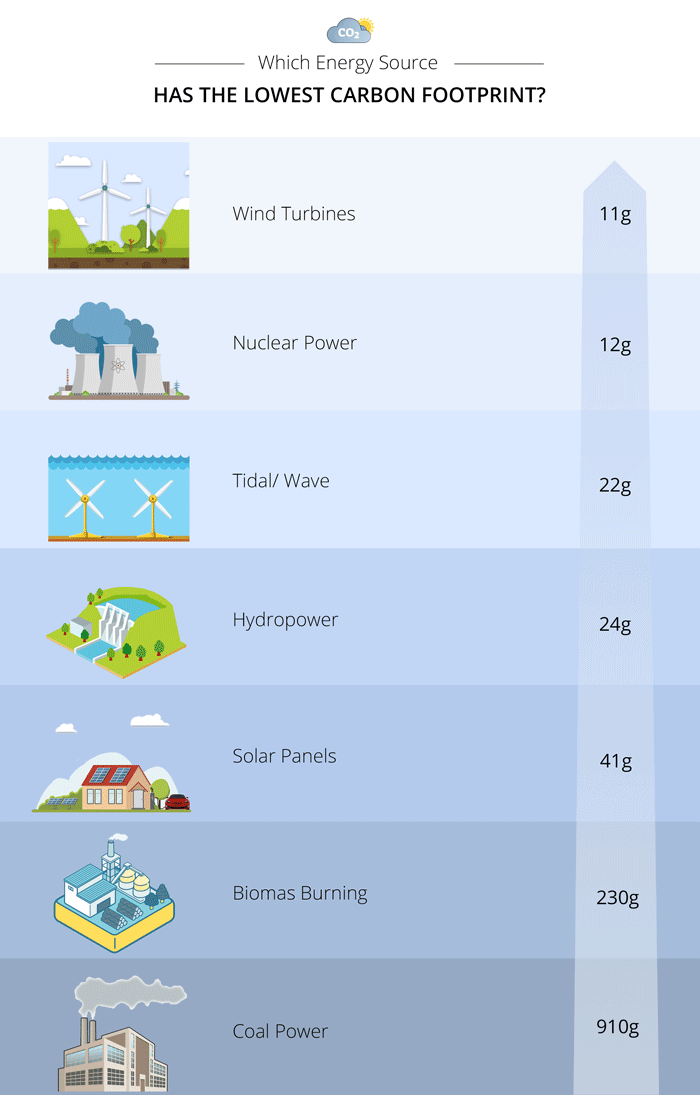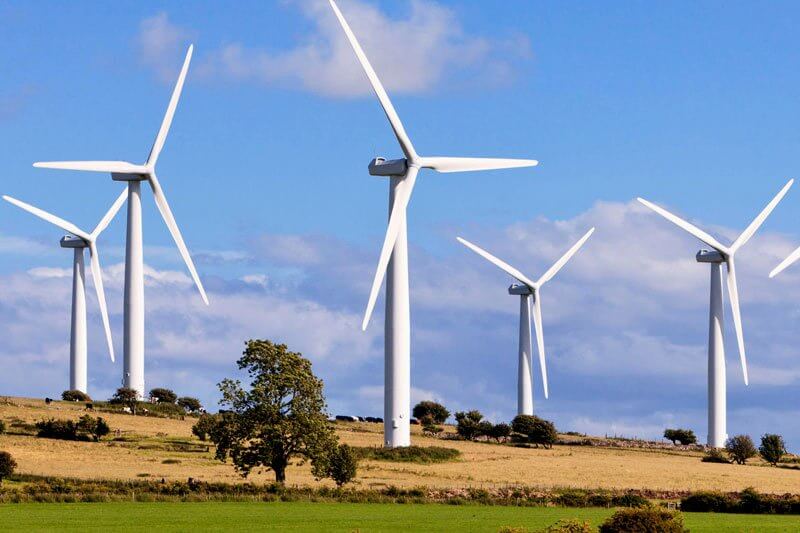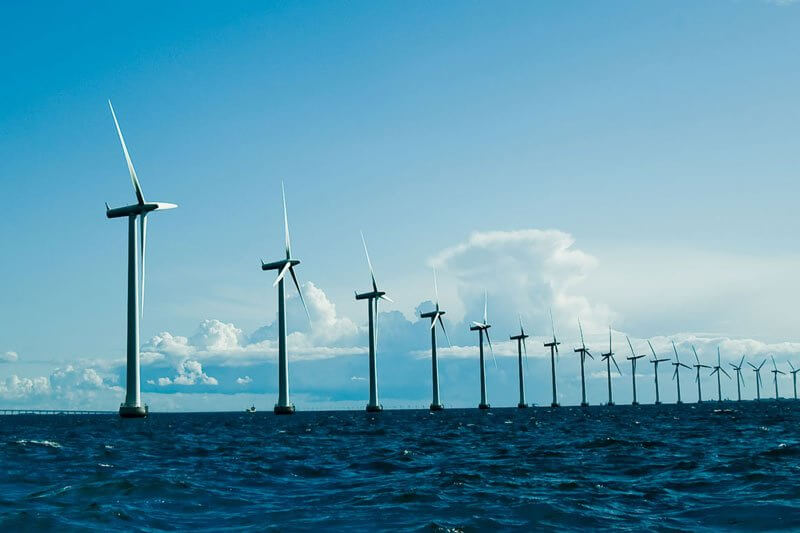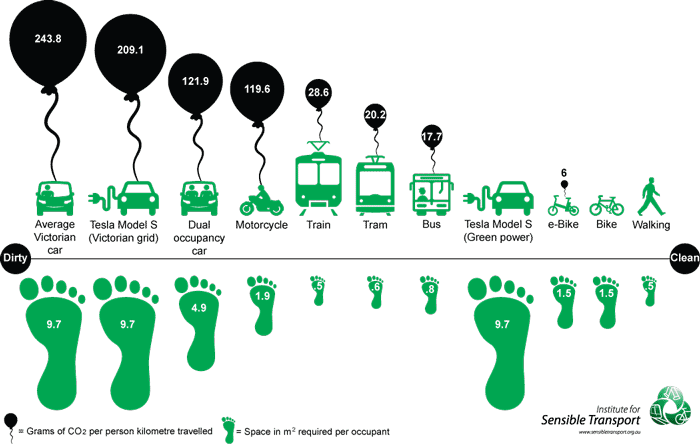Home Which Energy Sources Have the Lowest Carbon Footprint?
Which Energy Sources Have the Lowest Carbon Footprint?
Every method of generating power has its own carbon emissions footprint, no matter what form it’s in. More sustainable options, such as solar power, also generate carbon emissions due to the required processes for making the panels. This involves sourcing the materials needed, the steps involved in producing them, and the transportation of the panels to their final destination.
The least CO2 is produced by wind and nuclear at 11 g and 12 gCO2/kWh respectively. Next is tidal, hydropower and solar which emit between 22 to 41 gCO2/kWh on a daily basis. These energy sources aid in the fight against climate change and offer several environmental benefits.
Therefore, we will investigate numerous energy sources to see which one provides the best alternative for a world free of greenhouse gases.
| Energy type | Carbon footprint gCO2 per KWh |
|---|---|
| Wind | 11 g |
| Nuclear | 12 g |
| Tidal | 22 g |
| Hydropower | 24 g |
| Solar Energy | 41 g |
| Biomass | 230 g |
| Natural Gas | 450 g |
| Coal | 910 g |

Table of Contents
ToggleWhat do you mean by a carbon footprint?
A carbon footprint is the entire amount of greenhouse gas (GHG) emissions created by an individual, organization, event, or product, both directly and indirectly.
It is estimated by adding the emissions from each stage of a product’s or service’s life cycle (material production, manufacturing, use, and end-of-life). Various GHGs, such as carbon dioxide (CO2), methane (CH4), and nitrous oxide (N2O), may be emitted during a product’s existence, or lifecycle, each with a higher or lesser capacity to trap heat in the atmosphere.
The global warming capability (GWP) of each gas accounts for these variances, resulting in a carbon footprint in units of mass of carbon dioxide equivalents (CO2e).
In terms of safety and carbon emissions, fossil fuels are the dirtiest and most dangerous energy sources, whereas nuclear power and current renewable energy sources are far safer and cleaner. Now keep reading to find out why some energy sources are safe and some are not.
Types of greenhouse gases
Greenhouse gases absorb the sun’s infrared light, keeping its heat inside our atmosphere. As a result, global warming and climate change occur. Extreme weather, rising sea levels owing to ice melting, species extinction, and other negative repercussions of global warming are only a few examples. Without a solution, this will only worsen.
Carbon dioxide, methane, nitrous oxide, and industrial gases such as hydrofluorocarbons (HFCs), sulfur hexafluoride (SF6), perfluorocarbons (PFCs), and nitrogen trifluoride are the principal greenhouse gases emitted by human activities and energy production (NF3).
Carbon dioxide is the principal emission from energy generation, and it has a tremendous impact on our ecosystem.
Which energy sources generate the lowest carbon footprint?
Let’s look at the various energy sources to find out. Water, sun, wind, fossil fuels, tidal, nuclear, and biomass are the most common energy sources.
#1. Wind energy
Wind energy is another renewable energy source that can help us minimize our carbon footprint and avert global warming disasters. In fact, wind energy is one of the most environmentally benign ways to create electricity. During operation, wind turbines emit no pollutants into the air or water.
We can begin to turn the gears of global warming if we capture more wind energy to generate power. This is because the need for fossil fuels such as coal and oil will fall dramatically, leading to lower carbon emissions in the atmosphere.
More green energy equals less air pollution. Reduced global warming also means fewer incidences of species extinction and more biodiversity.
How much CO2 is emitted by wind energy?
Wind turbines emit only 11 grams of CO2 every kilowatt-hour of power generated, according to calculations. This figure is based on the CO2 emitted during the manufacturing process as well as the maintenance required to maintain them.
Wind power has a carbon footprint that is 99% less than coal-fired power plants, 98% less than natural gas, and a surprising 75% less than solar, according to researchers that wrote off the initial cost of the carbon over the equipment’s decades-long lifespan.
#2. Nuclear energy
During operations, nuclear power reactors will release no greenhouse emissions. However, nuclear power will emit some carbon dioxide during its lifetime. It emits the same amount of CO2 as wind energy for every kilowatt-hour of power produced.
On the other hand, it creates only one-third of the CO2 emissions that solar energy does per kilowatt-hour. Although not a renewable energy source, nuclear energy is one of the cleanest forms of energy in terms of greenhouse gas emissions.
How much CO2 is emitted by nuclear power plants?
Nuclear power has the third-lowest carbon footprint of any source of energy. On a life-cycle basis, nuclear power emits 12 grams of CO2 for every kWh produced. It fights climate change and provides a variety of environmental benefits, but it also poses the risk of nuclear waste.
#3. Tidal energy
Tidal energy is a prominent renewable energy source. Tidal power is a well-known green energy source, releasing no greenhouse gases. It also doesn’t take up much room.
How much CO2 is emitted by tidal energy?
Tidal energy emits less than 22 grams of CO2 per kilowatt-hour across the whole life cycle of the technology. Wave systems require more research, but they emit extremely little CO2. Tidal and wave energy emit a fraction of the CO2 that coal power stations do (820 gCO2 per KWh).
#4. Hydro energy
Hydropower, or hydro energy, is a fantastic source of clean, sustainable energy. It is mostly used to generate commercial electricity. A regulated flow of water is created by constructing a barrier on a water reservoir to drive turbines, creating power.
This green energy source may be more reliable than other renewable energy sources such as wind or solar.
Hydro energy and CO2 emissions
While being a green source of energy, some projects may result in CO2 emissions. Research has still shown some evidence of greenhouse gas emissions from this source, which is that as flooded organic things decay, reservoirs generated by hydropower dams can be a source of greenhouse gases.
In some cases, though, the same reservoir can become a carbon sink by taking more carbon from the air than it normally produces.
Overall, research reveals that substituting fossil fuels in the production of energy with hydropower has averted nearly 100 billion tons of CO2 from entering the atmosphere in just 50 years. This is far greater than the amount avoided by nuclear power.
#5. Solar Energy
The sun is one of the most environmentally friendly energy sources. Solar energy systems generate power and emit no greenhouse gases, so they provide no harm to the environment. As a result, solar energy may be a viable alternative to fossil fuels in the quest to reduce global warming.
Are solar panels associated with pollution?
Some people remain skeptical of solar energy because they do in fact leave a carbon footprint. They claim that carbon dioxide is emitted throughout the solar panel manufacturing procedure. That is certainly correct!
Solar panels are mostly silicon and are used to generate solar power. Silicon requires extremely high heat levels during the production process.
Once manufactured, however, solar panels generate clean electricity for up to 25 years which is far better than burning fossil fuels.
How much CO2 is emitted during the solar panel manufacturing process?
To determine which energy source produces the fewest greenhouse gases, we must first calculate how much CO2 each energy source produces. In the first few years of operation, this procedure usually emits roughly 50g of CO2 per kilowatt-hour. This amount of CO2 is over 20 times less than what other energy sources, such as coal, produce. In this light, solar panels will be carbon-free after three years of power output.
Solar energy is an excellent solution for reducing your carbon footprint and saving the world. Furthermore, there are various high-quality but low-cost solar panels available for purchase online for this reason.
You can start saving the world by using this calculator to calculate your carbon footprint.

Which energy sources generate the most Co2?
Fossil fuels
These are the primary sources of greenhouse gases in the environment. Coal, natural gas, and oil are examples of fossil fuels. Almost everything on the planet now operates on fossil fuels. For example, oil is used for transportation and heating; coal for electricity generation; and natural gas for heating. All of these actions will eventually result in the release of greenhouse gases into our atmosphere.
The combustion of fossil fuels emits large volumes of CO2. This is a significant greenhouse gas, which contributes to global warming. According to a few current studies, global warming has currently increased by about 1 °C, and if this rise exceeds 1.5 °C, the consequences will be disastrous.
According to a 2018 IPCC (intergovernmental panel on climate change) report, fossil fuels and industry account for around 89 percent of global CO2 emissions, which is huge!
- Coal contributes the most CO2, accounting for more than 0.3°C of the overall global temperature change.
- When oil is burned, it emits significant amounts of carbon dioxide. In reality, it accounts for almost one-third of global carbon emissions. Worse, if this oil spills onto land or water, the consequences can be disastrous.
- Natural gas is frequently regarded as the superior of the three fossil fuel sources. However, it emits a huge quantity of carbon into the atmosphere – almost one-fifth of worldwide emissions.
Finding alternative, more environmentally friendly energy sources is our only option if we want to protect our world.
Biomass energy
Biomass energy is a clean, renewable energy source. It is a fantastic substitute for fossil fuels. While biomass burning produces CO2, a greenhouse gas, it does not normally emit more CO2 into the sky.
How does it work?
The amount of CO2 emitted during biomass burning is the same as the amount captured and removed from the environment by these plants. This indicates that the equation is a balanced equation. There will be no extra carbon dioxide.
Biomass may be used for heating, cooking, and transportation, reducing the need for fossil fuels such as natural gas and oil. This type of energy is also renewable because we can always plant new plants.
FAQ's
Clean energy is energy with the lowest carbon footprint, excluding hydropower. Clean energy is an energy substitute for fossil fuels (such as coal, oil, and natural gas) that can help to mitigate global warming by decreasing global greenhouse gas emissions (GHGs). It is obtained from activities that do not emit GHGs into our atmosphere but may have geographical constraints and intermittent productivity peaks dependent on weather conditions.
In 2019, over 80% of the world’s energy comes from the combustion of fossil fuels, with only about 8.5 percent coming from clean energy sources.
Onshore wind energy:
It is generated by turbines that are positioned on land. The costs of construction, transportation, repair, and infrastructure required to transmit electricity from onshore turbines to customers are minimal. However, because onshore wind speed and direction can be unexpected, they may be less efficient.

Offshore wind energy
Turbines in the ocean or freshwater are used for offshore wind generation. The cost of building, transporting, maintaining, and constructing the infrastructure required to distribute electricity from offshore turbines to customers is expensive.
Offshore turbines are far larger than onshore turbines and might cost up to 20% more. The potential for energy generation is substantially greater because wind speed and direction are more consistent. In comparison to onshore turbines, worries about noise pollution, land utilization, and wildlife effects are limited.

Table of Contents
Toggle





